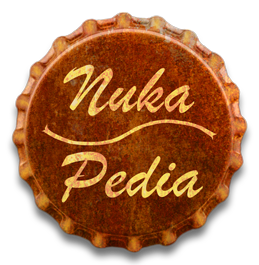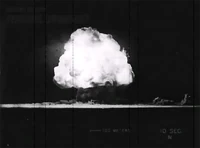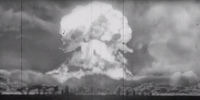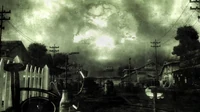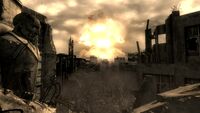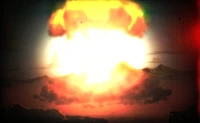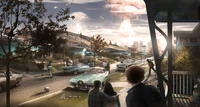The Great War started and ended on Saturday, October 23, 2077 when nuclear weapons were launched by all the nuclear-capable nations of the Fallout world (mainly from the United States, China and the USSR). The exchange lasted for approximately two hours, according to most survivors' accounts. Once the last atomic bomb and nuclear warhead had fallen, the world fell into the deep darkness of a nuclear holocaust.
Prelude
The geopolitical situation that led to the outbreak of the long-feared global nuclear war was prompted primarily by the onset of a worldwide energy crisis when the supplies of fossil fuels finally began to run out by the year 2050. This energy crisis was in part the result of the ever-increasing amounts of fossil-fuel required to power the Fallout world's larger and less energy-efficient technologies when compared with those of our own world, due to their failure to develop miniaturized electronics and more advanced manufacturing materials.
The result of this energy crisis was an increasing scramble by all of the advanced, industrialized nations to secure the few remaining supplies of untapped petroleum around the world. Ultimately, a series of military conflicts driven by this hunger for natural resources consumed the planet. The European Commonwealth had reacted to the rapid raising of oil prices to unacceptably high levels by the Middle East's oil-rich states in 2052 by unleashing military action in that region of the world. This intervention ultimately resulted in the destruction of the Israeli city of Tel Aviv in December 2053 by a terrorist nuclear device and a limited nuclear exchange between the conflict's participants in 2054, the world's first since the end of WWII.
As the United Nations tried with little success to keep the peace, many of that organization's member-states pulled out, and within two months of the outbreak of what was soon called the Resource Wars in 2052, the United Nations was disbanded. Next, following the breakdown of trade talks and the unilateral American exploitation of the world's last newly discovered reserves of crude oil, the Chinese invaded Alaska in 2066 in pursuit of the state's remaining oil reserves. The United States ultimately annexed Canada in 2076 to ensure Canadian support for its defense of the Alaskan front even as the American federal government acted aggressively against its own citizens to contain wartime rioting, anti-war civil disobedience and military desertion.
The United States retaliated against the Chinese by launching its own costly invasion of the Chinese mainland in 2074 to reduce Chinese pressure on the Alaskan front. Despite initial costly setbacks, this strategy proved successful and American forces liberated the Alaskan city of Anchorage and forced the Chinese People's Liberation Army to retreat entirely from American soil in January 2077. This victory was largely won due to the more advanced military technology developed by the United States during the conflict, especially the deployment of Powered Infantry Armor. Many smaller nations went bankrupt in the ensuing conflict as their economies collapsed due to the increasing shortage of fossil-fuels. The Resource Wars ended with the Great War in 2077.
The Great War
It is not known who launched the first nuclear weapon that started the conflict. President Richardson would tell the Chosen One that China launched first; however, it is not known if he was telling the truth. At 12:03am on October 23rd, the US Navy Pacific Fleet (COMPACFLT) reported three unidentified submerged objects (possibly Chinese submarines [1]) off the California coastline. A little over three hours later, US Air Force fighters spotted a squadron of unknown aircraft at high altitude off the Bering Straits of Alaska at 3:37am Eastern Time. Four probable nuclear missile launches were detected by the Integrated Operational Nuclear Detection System (IONDS) at 9:13am, with DEFCON 2 being declared. Four minutes later at 9:17am, NORAD confirms nuclear missile launches and bombers were immediately scrambled on combat sortie. DEFCON 1 was declared simultaneously. Response scenario protocol "MX-CN91" was enacted by the President at 9:26am, authorizing the immediate launch of U.S. nuclear weapons. Nuclear missile strikes on New York City and Pennsylvania were confirmed at 9:42am, with nuclear strikes on Boston and Washington occurring at 9:47am. [2]
The nuclear exchange that characterized the Great War lasted for only a brief two hours, but was unbelievably destructive and reshaped the climate of the world even as it caused the fall of most of human civilization everywhere across the globe. More energy was released in the first moments of the Great War than all of the previous human conflicts in the history of the world combined. Entire mountain ranges were created as the ground buckled and moved under the strain of the cataclysmic pressure produced by numerous, concentrated atomic explosions. Rivers and oceans around the world were contaminated with the resulting radioactive fallout released by the relatively low-yield nuclear weapons used by all sides, and the climate changed horrifically. All the regions of Earth suffered from a single, permanent season once the initial dust blasted into the atmosphere by the nuclear explosions had settled – a scorching, radioactive desert summer.
In the United States, the west coast was the first area hit by the bombs, allowing the east coast to receive a small warning. Most major cities were devastated. On the east coast, Pennsylvania and New York were among the first to be hit by the bombs, with Massachusetts and Washington D.C. being struck shortly afterwards.
Aftermath
Many American citizens did not heed the air raid sirens on October 23, 2077, believing them to be signaling just another drill. The Vaults sealed in their inhabitants as Earth burned in atomic fire. A few citizens took shelter where they could: sewers, subway stations, drainage centers, Pulowski Preservation shelters, or in the case of the Keller family, the National Guard depot. However, without a very strong outer shield of dense metal or rock to defend them from both the heat and kinetic shock wave of the nuclear blasts (such as Lamplight caverns or Raven Rock), few civilians survived the full-out nuclear exchange. Some who were exposed to high levels of radiation became ghouls, and some of these ghouls, in turn, formed their own communities. Those who survived the nuclear exchange would form the basis for the brutal civilization that existed for the next twenty years until the first Vaults reopened.
Despite the global destruction caused by the war, many areas remained habitable, with low and tolerable levels of radioactive fallout. The surviving humans in those parts of Earth were able to continue living in the ruins of the pre-War civilization, establishing new communities and even small cities.
According to both the Shi and Randall Clark, there was a great nuclear EMP-produced blackout following the war.[3]
Around a week after the initial nuclear explosions, rain started to fall; however, none of it was drinkable. The rain was black; tainted with soot, ash, radioactive elements produced by the nuclear explosions, and various other contaminants produced by nuclear weapons. This rain marked the start of the terrible fallout that marked the true, permanent destruction caused by the Great War. The rain lasted four long days, killing thousands of species that had survived the initial destruction of the bombs, be they animals, plants, or microorganisms. Those few living things – human, animal, or plant – that survived after the rain ended were left to live in the now-barren wasteland that had spread across Earth, where nearly all pre-War plant life had died either in the initial explosions or from the intense radiation produced by the fallout.
Some major global cities were not completely destroyed by the explosions because of their relatively low explosive yields, and cities such as Washington, D.C. even managed to maintain intact buildings, despite relatively close detonations. However, most city streets across the post-nuclear United States were (and continue) to be blocked with rubble from collapsing edifices. In the ruins of Washington, D.C., most of the city's Metro system of subways remained intact. Though many Metro tunnels were blocked by collapsed masonry caused by the shock of the atomic explosions, the Metro's tunnel network remains the easiest, if not the only, way to move around the D.C. ruins.
Thanks to the efforts of Robert House, most of the city of Las Vegas, Nevada and the Hoover Dam remained intact, and many buildings still have electricity as of 2281. About twelve years before the Great War, House predicted when the bombs would fall. In the meantime, he installed defenses such as point-defense laser cannon turrets on the roof of the Lucky 38 casino, and heavy computing power to brute-force the disarm codes to the Chinese atomic warheads. The brute-force disarming handled the majority of the nuclear weapons targeting the Mojave region, while the lasers handled most of the rest before they hit Las Vegas. Had his platinum chip been delivered only a day earlier, an even greater area of the Mojave Wasteland could have been spared the terrible destruction. In time, the remains of Las Vegas came to be known as New Vegas.
Notes
- There was debate on what time the Great War occurred and whether it happened in the morning or at night due to several inconsistencies being created throughout the Fallout games.
- All clocks on the East Coast are stuck at 9:47.
- In the Fallout: New Vegas add-on Honest Hearts, clocks found in the debris of Three Marys are also stopped at 9:47. This is despite the fact that Three Marys would be several time zones away from the East Coast, and so simultaneous bombings would not result in the same time stuck on the different clock faces.
- Though as Fallout: New Vegas borrows some textures and models from Fallout 3, it could be a lack of texture change.
- According to the Fallout: New Vegas add-on Dead Money, the bombs were launched during the night of the Gala Event, suggesting that the nuclear holocaust happened when people were sleeping on the East Coast and getting home from work on the West Coast. This also supports the ideas that people simply did not heed the air raid sirens or didn't have enough time to get to safety.
- The opening narration of Old World Blues also explicitly stated the bombs fell during the night.
- According to Carrie Delaney's holotapes, the school was packing up to leave Little Lamplight after a field trip. This could place the East Coast bombs in the 2–3 PM time range, unless they had stayed overnight prior.
- Mr. House, meanwhile, says that the Platinum Chip was to be delivered in the afternoon of October 23, "but by then, the world had ended".
- The beginning of Fallout 4 starts out in pre-War Boston in the morning, only moments before the bombs fall, showing that the Great War occurred at 9:47am Eastern time, rather than at night. New York and Pennsylvania were hit at 9:42am[4], with Boston and Washington, D.C. being hit at 9:47am, five minutes after.[verification needed]
- This would mean the West Coast was hit around 6:30-6:40 AM, due to the differing time zones and travel time for the missiles. This is before sunrise in October, so it would technically still be night.
- The war is sometimes referred to as World War III by fans and on the Fallout Trilogy PC cover. In the Fallout intro, the narrator states that "the storm of world war had come again". However, none of the in-game characters in the series have ever referred it as such.
- In real life, however, a nuclear holocaust is usually associated with the hypothetical World War III.
Behind the scenes
| The following is based on design documents from the cancelled Fallout movie and is not canon. |
According to the script of the Fallout film, neither China, the United States, nor Russia launched the first bomb. It was in fact Vault-Tec's executive of the vaults. He launched the first bomb to fulfill his own prophecy of nuclear annihilation.
| End of information based on design documents from the cancelled Fallout movie and is not canon |
Gallery
References
- ↑ It is possible these unknown submarines are of the "Ghost Fleet" mentioned in the Switchboard terminals, an elite Chinese unit of Yangtze-class submarines rumored to be equipped with stealth capabilities similar to that of the Hei Gui stealth suits. The terminal also goes on to mention that ships of the "Ghost Fleet" have reportedly been spotted by US monitoring stations A-31 and B-19 in November 2075. However, no further sightings were apparently reported, so it is unknown if the Chinese attempts were successful.
- ↑ "DEFCON Status- 2077", found on locked Expert terminal in Switchboard facility underneath Slocum Joe's Donuts in Fallout 4.
- ↑ The Shi inhabitants of San Francisco claim to be the descendants of the Chinese People's Liberation Army Navy submarine Shi-Huang-Ti (named after the first Chinese emperor), washed ashore in the great nuclear EMP-produced blackout following the Great War.
- ↑ The Switchboard terminal entries
